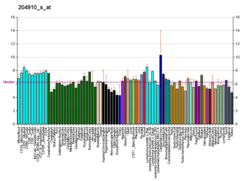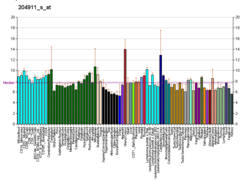Protein-coding gene in the species Homo sapiens
| TRIM3 |
|---|
|
| Identifiers |
|---|
| Aliases | TRIM3, BERP, HAC1, RNF22, RNF97, tripartite motif containing 3 |
|---|
| External IDs | OMIM: 605493; MGI: 1860040; HomoloGene: 21290; GeneCards: TRIM3; OMA:TRIM3 - orthologs |
|---|
| Gene location (Human) |
|---|
 | | Chr. | Chromosome 11 (human)[1] |
|---|
| | Band | 11p15.4 | Start | 6,448,613 bp[1] |
|---|
| End | 6,474,459 bp[1] |
|---|
|
| Gene location (Mouse) |
|---|
 | | Chr. | Chromosome 7 (mouse)[2] |
|---|
| | Band | 7|7 E3 | Start | 105,253,670 bp[2] |
|---|
| End | 105,282,778 bp[2] |
|---|
|
| RNA expression pattern |
|---|
| Bgee | | Human | Mouse (ortholog) |
|---|
| Top expressed in | - cerebellar hemisphere
- right hemisphere of cerebellum
- mucosa of transverse colon
- right frontal lobe
- paraflocculus of cerebellum
- tibial nerve
- body of uterus
- right coronary artery
- popliteal artery
- tibial arteries
|
| | Top expressed in | - cerebellar cortex
- neural layer of retina
- primary visual cortex
- superior frontal gyrus
- cerebellar vermis
- lobe of cerebellum
- dentate gyrus of hippocampal formation granule cell
- prefrontal cortex
- piriform cortex
- lateral geniculate nucleus
|
| | More reference expression data |
|
|---|
| BioGPS | 

 | | More reference expression data |
|
|---|
|
| Gene ontology |
|---|
| Molecular function | - zinc ion binding
- protein C-terminus binding
- protein binding
- metal ion binding
- ubiquitin protein ligase activity
- ubiquitin-protein transferase activity
| | Cellular component | - cytoplasm
- endosome
- early endosome
- intracellular anatomical structure
- Golgi apparatus
- dendrite
- cell projection
| | Biological process | - protein transport
- protein ubiquitination
- nervous system development
- protein polyubiquitination
- proteasome-mediated ubiquitin-dependent protein catabolic process
| | Sources:Amigo / QuickGO |
|
| Orthologs |
|---|
| Species | Human | Mouse |
|---|
| Entrez | | |
|---|
| Ensembl | | |
|---|
| UniProt | | |
|---|
| RefSeq (mRNA) | |
|---|
NM_001248006
NM_001248007
NM_006458
NM_033278
NM_033279 |
| |
|---|
NM_001285870
NM_001285871
NM_001285873
NM_018880
NM_001360425 |
|
|---|
| RefSeq (protein) | |
|---|
NP_001234935
NP_001234936
NP_006449
NP_150594 |
| |
|---|
NP_001272799
NP_001272800
NP_001272802
NP_061368
NP_001347354 |
|
|---|
| Location (UCSC) | Chr 11: 6.45 – 6.47 Mb | Chr 7: 105.25 – 105.28 Mb |
|---|
| PubMed search | [3] | [4] |
|---|
|
| Wikidata |
| View/Edit Human | View/Edit Mouse |
|
Tripartite motif-containing protein 3 is a protein that in humans is encoded by the TRIM3 gene.[5][6]
The protein encoded by this gene is a member of the tripartite motif (TRIM) family, also called the 'RING-B-box-coiled-coil' (RBCC) subgroup of RING finger proteins. The TRIM motif includes three zinc-binding domains, a RING, a B-box type 1 and a B-box type 2, and a coiled-coil region. This protein localizes to cytoplasmic filaments. It is similar to a rat protein which is a specific partner for the tail domain of myosin V, a class of myosins which are involved in the targeted transport of organelles. The rat protein can also interact with alpha-actinin-4. Thus it is suggested that this human protein may play a role in myosin V-mediated cargo transport. Alternatively spliced transcript variants encoding the same isoform have been identified.[6]
Interactions
TRIM3 has been shown to interact with Actinin alpha 4.[7]
TRIM3 binds to and ubiquitinates Estrogen receptor alpha (ERa) leading to receptor's stabilization.[8]
Moreover, TRIM3 interacts with P53 which promotes the formation of K48-linked poly-ubiquitin chains and degradation.[9]
References
- ^ a b c GRCh38: Ensembl release 89: ENSG00000110171 – Ensembl, May 2017
- ^ a b c GRCm38: Ensembl release 89: ENSMUSG00000036989 – Ensembl, May 2017
- ^ "Human PubMed Reference:". National Center for Biotechnology Information, U.S. National Library of Medicine.
- ^ "Mouse PubMed Reference:". National Center for Biotechnology Information, U.S. National Library of Medicine.
- ^ El-Husseini AE, Vincent SR (July 1999). "Cloning and characterization of a novel RING finger protein that interacts with class V myosins". The Journal of Biological Chemistry. 274 (28): 19771–19777. doi:10.1074/jbc.274.28.19771. PMID 10391919.
- ^ a b "Entrez Gene: TRIM3 tripartite motif-containing 3".
- ^ El-Husseini AE, Kwasnicka D, Yamada T, Hirohashi S, Vincent SR (January 2000). "BERP, a novel ring finger protein, binds to alpha-actinin-4". Biochemical and Biophysical Research Communications. 267 (3): 906–911. doi:10.1006/bbrc.1999.2045. PMID 10673389.
- ^ Zhuang T, Wang B, Tan X, Wu L, Li X, Li Z, et al. (April 2022). "TRIM3 facilitates estrogen signaling and modulates breast cancer cell progression". Cell Communication and Signaling. 20 (1): 45. doi:10.1186/s12964-022-00861-z. PMC 8991925. PMID 35392925.
- ^ Wang X, Zhang Y, Pei X, Guo G, Xue B, Duan X, Dou D (November 2020). "TRIM3 inhibits P53 signaling in breast cancer cells". Cancer Cell International. 20 (1): 559. doi:10.1186/s12935-020-01630-z. PMC 7685606. PMID 33292295.
Further reading
- El-Husseini AE, Kwasnicka D, Yamada T, Hirohashi S, Vincent SR (January 2000). "BERP, a novel ring finger protein, binds to alpha-actinin-4". Biochemical and Biophysical Research Communications. 267 (3): 906–911. doi:10.1006/bbrc.1999.2045. PMID 10673389.
- El-Husseini AE, Fretier P, Vincent SR (February 2001). "Cloning and characterization of a gene (RNF22) encoding a novel brain expressed ring finger protein (BERP) that maps to human chromosome 11p15.5". Genomics. 71 (3): 363–367. doi:10.1006/geno.2000.6452. PMID 11170753.
- Reymond A, Meroni G, Fantozzi A, Merla G, Cairo S, Luzi L, et al. (May 2001). "The tripartite motif family identifies cell compartments". The EMBO Journal. 20 (9): 2140–2151. doi:10.1093/emboj/20.9.2140. PMC 125245. PMID 11331580.
- Lee SJ, Choi JY, Sung YM, Park H, Rhim H, Kang S (August 2001). "E3 ligase activity of RING finger proteins that interact with Hip-2, a human ubiquitin-conjugating enzyme". FEBS Letters. 503 (1): 61–64. doi:10.1016/S0014-5793(01)02689-8. PMID 11513855. S2CID 42977319.
- Yan Q, Sun W, Kujala P, Lotfi Y, Vida TA, Bean AJ (May 2005). "CART: an Hrs/actinin-4/BERP/myosin V protein complex required for efficient receptor recycling". Molecular Biology of the Cell. 16 (5): 2470–2482. doi:10.1091/mbc.E04-11-1014. PMC 1087250. PMID 15772161.
- Olsen JV, Blagoev B, Gnad F, Macek B, Kumar C, Mortensen P, Mann M (November 2006). "Global, in vivo, and site-specific phosphorylation dynamics in signaling networks". Cell. 127 (3): 635–648. doi:10.1016/j.cell.2006.09.026. PMID 17081983. S2CID 7827573.



















